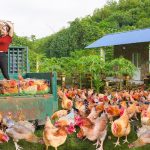Vertical Farming at Home to Produce Fresh Vegetables for Local Supermarkets
The Urban Agriculture Renaissance
A proliferation of compact urban farms signals a shift in how fresh produce reaches city dwellers. Vertical farming at home exploits underutilized spaces to grow nutrient dense vegetables in stacks of modules. Fresh lettuce microgreens and herbs harvested daily reduce transit time to local shops by hours. This model fosters hyperlocal food networks that undercut spoilage and packaging waste. Home operators convert basements or sunrooms into verdant vertical arrays by integrating horticultural science with savvy market linkages. The ensuing supply chain becomes shorter and more transparent allowing small scale growers to command premium pricing for super fresh yield.
Core Components of a Home Scale Vertical Farm
Structural Design
Robust frame assemblies anchor multiple growing tiers in a compact footprint. Lightweight aluminum extrusions resist corrosion while supporting hydroponic channels or soil trays. Modular rack systems enable quick reconfiguration when experimenting with crop combinations or nutrient regimes. Floor to ceiling installations maximize vertical real estate without impeding foot traffic. Reinforced shelving rated for 50 kilograms per level ensures safety when fully laden with water and plants. Wall anchors and cross braces maintain rigidity and dampen vibration from auxiliary equipment.
Growing Systems
Three principal soilless approaches excel in home settings. Hydroponic raft beds float plants on nutrient solutions that circulate through reservoirs. Aeroponic towers suspend roots in mist enriched with dissolved minerals. Aquaponic loops marry fish tanks with plant channels recycling effluent as fertilizer. Each system varies in startup costs water usage and maintenance demands. Home growers select based on space constraints desired crop types and technical comfort with plumbing and pump upkeep.
Substrate and Root Zones
Where media based systems prevail they incorporate inert materials to anchor roots. Coco coir retains moisture while resisting compaction. Perlite and vermiculite promote aeration preventing root suffocation. Crushed clay aggregate offers ballast and fosters beneficial microbial activity. Layered substrates enable deep rooting for larger vegetables. pH neutral blends preserve nutrient availability across a broad crop spectrum.
Environmental Control Systems
Climate and Temperature Regulation
Maintaining steady temperatures accelerates plant metabolism ensuring rapid turnover. Precision thermostats signal heating mats or HVAC units to engage when ambient conditions drift. Daytime setpoints at 22 to 26 degrees Celsius suit most vegetables. Night drops to 18 to 20 degrees reinforce natural diurnal cycles. Insulation panels on exterior walls diminish energy loss and buffer against outdoor fluctuations.
Humidity and Airflow
Roots thrive in moist air yet excessive moisture invites mold and mildew. Humidity sensors trigger dehumidifiers or misting nozzles to hold relative humidity between 60 and 70 percent. Oscillating fans set at low speed distribute air gently preventing pockets of stagnation. Filtered intake vents draw fresh carbon dioxide for photosynthesis while expelling stale air.
Hydroponic Aeroponic and Aquaponic Options
Hydroponic NFT channels maintain a thin film of nutrient solution along root mats. This method offers low water use and rapid root oxygenation. Aeroponic towers atomize nutrient rich mists at precise intervals cultivating ultra fine roots that absorb nutrients efficiently. Aquaponic loops integrate tilapia or koi tanks producing nitrogenous waste converted by biofilters into nitrates. Plants consume these nitrates closing the loop and reducing water change frequency.
Energy Efficiency Measures
LED plant lights calibrated to specific spectral bands consume 60 percent less electricity compared to older fixtures. Dimming schedules tied to ambient daylight prevent over lighting. Timer based pumps and solenoid valves limit run times reducing pump wear and slashing power bills. Smart outlets provide usage analytics guiding further efficiency tweaks.
Photonic Provisions
LED Spectrum Customization
Matching photon wavelengths to chlorophyll absorption peaks improves growth. Blue spectrum bands focus on leaf proliferation while red bands accelerate flowering and fruit set. Programmable LED bars allow dynamic shifts between growth cycles. Growers adjust blue to red ratios mid cycle to coax microgreens into rapid expansion then bolster fruiting stages.
Diurnal Light Cycles and Photoperiodism
Plants perceive day length as seasonal signals. Lettuce and kale accept 16 hour light spans while short day crops like spinach thrive under 12 hours. Gradual ramp up and ramp down simulates dawn and dusk softening stress responses. Automated dimming across thirty minutes prevents sudden transitions that can shock tender seedlings.
Nutrient Management
Formulating Balanced Solutions
A custom nutrient blend includes nitrogen phosphorus potassium calcium magnesium and micros such as iron manganese zinc copper boron and molybdenum. Precision scales measure salts into solution tiers. Stock solutions stored in amber jugs avoid photodegradation. Mixing water temperature stays between 20 and 25 degrees to optimize solubility.
Monitoring Ionic Strength and pH
Conductivity probes gauge total dissolved solids guiding dilution or concentration corrections. Ideal EC sits between 1.2 and 2.0 mS per centimeter depending on crop stage. pH meters prompt acid or base additions to hold pH at 5.8 to 6.2 ensuring nutrient bioavailability. Weekly calibration of meters maintains reading accuracy.
Crop Selection and Succession Planting
Fast Turnover Greens
Arugula mizuna and baby spinach sprout in under seven days seed to harvest. Lettuce varieties like butterhead and oak leaf yield within four weeks. Staggered sowing every week on successive tiers guarantees continuous pickings. This succession planting model multiplies total annual harvests.
Fruiting and Flowering Crops
Compact cherry tomatoes and pepper cultivars thrive in deeper substrate beds. Determinate growth habits simplify training within limited headspace. Clips and low tension ties guide vine direction keeping fruit accessible. Pollination by hand waving or bumblebee hives can raise yields when natural insects are absent.
Seasonal Rotation and Multi tiered Harvest
Upper tiers dedicated to sun loving fruiters while lower tiers host shade tolerant leafy greens. Seasonal rotation beds allow fall brassicas to replace spring lettuces adapting to cooler ambient light. Tiers reorganized mid year maintain optimal microclimates for each crop type.
Automation and Monitoring
Sensor Integration
Incorporate sensors to measure EC pH dissolved oxygen temperature humidity and CO₂. Data transmitted wirelessly to a cloud dashboard accessible on any device. Alerts notify growers when parameters drift beyond thresholds preventing crop failures.
Data Logging and Predictive Analytics
Historical data sets feed machine learning algorithms predicting nutrient drift and water needs. Forecasts on blossom end rot risk or powdery mildew outbreak enable preemptive interventions. Charts visualize yield per kilowatt hour guiding ROI improvements.
Automated Nutrient and Water Delivery
Peristaltic pumps draw stock solutions mixing on the fly into main reservoirs. Float switches monitor water levels preventing pump dry runs. Solenoid valves controlled by timers distribute precise volumes to each tier ensuring uniform hydration.
Economic Viability and Market Integration
Cost Analysis and Return on Investment
Initial outlay includes lighting racks pumps controllers grow trays and substrate tanks. Recurring expenses cover electricity water nutrients and replacement parts. Calculating break even takes into account local produce prices at supermarkets. At wholesale rates for microgreens the daily revenue can recoup capital in under eighteen months.
Branding and Packaging for Local Markets
Design minimal compostable clamshells with ventilation ridges preserving crispness. Attach QR codes linking to system parameters and grow logs appealing to transparency seekers. Brand names invoking freshness local heritage and sustainability draw consumer interest at point of sale.
Distribution Logistics
Daily harvests sorted by maturity shipped in cooled boxes maintain a four day shelf life. Partnering with independent organic grocers and farmers markets creates direct accounts. Cooperative delivery routes reduce transport costs and carbon footprint.
Risk Management and Disease Control
Preventing root pathogens requires strict sanitation. Remove dead leaf material daily preventing fungal spores from spreading. UV sterilizers fitted on recirculating loops combat Pythium and Fusarium. Quarantine new seed packets by germinating test batches under observation. In case of outbreak isolate affected tiers sealing vents to contain spores.
Integrated pest management targets aphids thrips and whiteflies without harsh chemicals. Release predatory mites and lacewing larvae to control sap sucking insects. Neem oil and potassium bicarbonate sprays applied during dark hours reduce phytotoxicity. Sticky traps capture winged adults before they leap across tiers.
Legal and Regulatory Landscape
In some jurisdictions small scale vertical farms escape agricultural licensing by growing indoors under roof. Check local municipal codes to ensure compliance with zoning and building ordinances. Food safety regulations may require registering as a food processor if billeing supermarkets. Adhere to Good Agricultural Practices by maintaining traceability from seed to shelf.
Organic certification extends credibility but demands buffer distances from conventional farms and documented input lists. Third party audits inspect nutrient sources and water testing protocols. Lab results for heavy metals and microbial pathogens must accompany batches destined for health conscious consumers.
Community Engagement and Partnerships
Collaborate with culinary schools and chefs hosting tasting events on site demonstrating craft growing techniques. Invite community volunteers to harvesting days fostering brand ambassadors. Schools visiting vertical farms learn science principles turning customers into advocates.
Join local producer associations sharing wholesale accounts and cross promotions. Group purchases of supplies reduce costs for all. Collective marketing at seasonal festivals amplifies visibility beyond single farms drawing more orders.
Story of a Home based Vertical Farmer
A former architect transformed a 12 square meter spare room into a vertical farm named SkyGreens Micro. Sketching rack layouts by night they repurposed aluminum scaffolding to assemble four tiers growing 180 lettuces per cycle. Harvesting before dawn and delivering to a family owned grocer led to a signature salad program. Within six months they expanded to living room stacks reaching 360 heads per week.
Weather extremes that once disrupted outdoor crops became irrelevant with indoor climate controls. Automated nutrient dosing freed up weekends while dash cam footage documented plant growth rates for social media sharing. Local chefs prized the uniform leaf shape and absence of pesticide residues.
SkyGreens Micro reinvested profits into solar panels and rainwater tanks slashing utility bills. A feature in a regional agricultural magazine sparked inquiries from ten aspiring growers. Mentorship programs sprouted led by the architect turned farmer guiding novices through design pitfalls. This cyclical knowledge sharing nurtured a small regional network of home vertical farms supplying multiple supermarket chains.
Advanced Tips and Tactical Tricks
- Install scalable racking on caster wheels for easy reconfiguration
- Use daylight harvesting windows leveraging natural light when possible
- Integrate companion planting with flowering basil next to greens to repel thrips
- Calibrate timers quarterly to adjust for seasonal daylight variation
- Rotate nutrient formulas monthly assessing bloom versus vegetative performance
- Employ biodegradable substrate liners to simplify crop changeovers
- Use color corrected cameras under grow lights to inspect leaf health remotely
- Store pH and EC calibration standards on site preventing sensor drift
- Conduct biannual substrate replacement every 18 months to suppress salt buildup
- Schedule deep cleaning of tanks with food safe cleaning agents every eight weeks
- Map power circuits distributing high draw devices across phases avoiding overload
- Place reflective Mylar sheets behind tiers boosting light usage by 10 percent
- Maintain a small emergency battery backup for critical controls during outages
- Test tap water monthly for hardness and chloramine adjusting filtration accordingly
- Leverage voice controlled smart assistants to trigger manual overrides hands free
Sustainability Metrics and Environmental Impact
Measure water use efficiency as liters consumed per kilogram of produce. Home vertical systems often achieve water savings of 90 percent compared to field growing. Track electricity usage per daily harvest and offset with solar or wind energy contributions. Monitor waste streams recycling spent substrate into compost for community gardens. Quantify carbon savings by replacing imported greens reducing transport emissions by hundreds of kilograms annually.
Scaling Beyond the Home
Once the home model proves profitable replicate modules in garages greenhouses or shipping containers. Franchising micro farms under a cohesive brand enables regional saturation without large land purchases. Training manuals based on initial data streamline new site startups reducing trial and error for newcomers.
Future Trends in Home Vertical Farming
Emerging nanoparticle sensors will detect nutrient deficits at molecular levels enabling split second corrections. Blockchain based traceability will embed farm data immutable on distributed ledgers enhancing consumer trust. AI vision systems will recommend pruning or thinning interventions based on leaf morphology analysis. Hybrid solar PV grow lights generating electricity and photosynthetically active radiation will lower overheads further.
Conclusion
Vertical farming at home redefines fresh vegetable supply chains unlocking market access for small operators. Integrating structural innovation environmental controls and precise nutrient management yields high density crops ready for local supermarkets. The story of a single micro farm illustrates potential to reshape urban agriculture through transparency quality and sustainability. By mastering technical aspects and forging community partnerships home growers can secure enduring success supplying racks of crisp greens to neighborhood markets every day.










